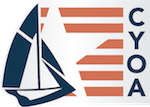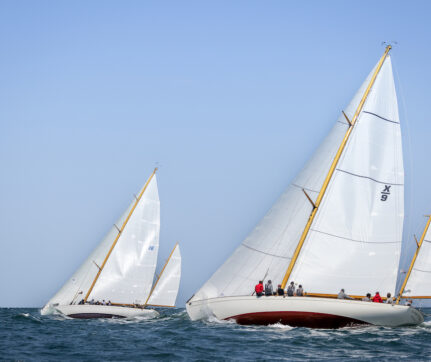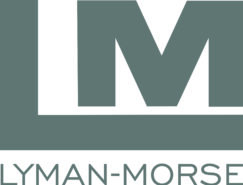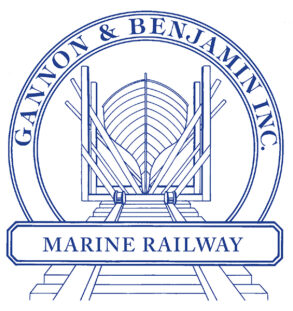By Jim Taylor, CYOA Technical Committee Chair
The CYOA Technical Committee does an in-depth review each year of Classic race results from the season just completed, with a primary focus on how accurately CRF ratings reflect actual on-the-water performance. The obvious goal is to equitably rate a full range of boat sizes and types over a variety of conditions, and this is a tall order given the diversity of the Classic fleet. Unfortunately, the weather gods did not cooperate in 2023, with light and variable conditions predominating early in the season and some gear busters coming late, and neither were of much help in evaluating the efficacy of a rating rule. There was a lot of very tight competition despite the conditions, however, and observations from the more straightforward races during the 2023 season did suggest the following takeaways:
- Boats with deep rated draft (especially via centerboard extension) again appeared disadvantaged
- Boats that are narrow for their length (eg 12m’s, L-24’s and ‘square meter’ designs) appeared advantaged.
- Schooners made regular appearances on the podium, which was great to see.
CRF is a fully transparent and objective ‘data in, rating out’ rule that does not apply any subjective ‘thumbs on the scale’, but it does depend on owner declared data, and it is refined on an annual basis based on the best information available. VPP-based rules that benefit from full professional measurement are the best yacht rating science available; the continuing development of CRF has routinely used VPP generated ratings as benchmarks when available and appropriate, and this use is especially helpful in years when empirical observations are difficult to make given the weather conditions. This year, trends shown in plots of rating deltas (CRF – VPP) vs both Length/Beam and Draft/Length ratios corroborate the ‘real world vs CRF’ observations noted above, and CRF 2024 will rate unusually narrow boats slightly (1-3 sec/mi) faster, and boats with unusually deep draft (especially via centerboard extension) a little (1-4 sec/mi) slower.
Beyond the two minor changes to the Length/Beam and Draft Corrections, the changes for CRF 2024 largely amount to house cleaning. The need for the first clean-up was revealed when two more true (100+ ft) superyachts received CRF ratings, these did not match up with their VPP based ratings especially well, and a subsequent in depth review revealed why: CRF ratings depend heavily on how much baseline numbers for Length/Beam, Disp/Length and SA/Disp (normalized for length) differ from those of the boat being rated. Since the 2017 beginning of what was first dubbed ‘CRF MkII’, those baseline reference numbers were calculated via a linear function, which worked fine (it represented typical classic fleet values well) for boats in our ‘normal’ size range, but they were found not to give reasonable values when extrapolated out to superyacht size. In order to do a better job when rating really big boats, those three linear functions have been changed to second order polynomial data fits for CRF 2024. These changes make virtually no difference in rating for boats less than about 65 feet LOA, but they do a much better job with boats 80 feet long and up.
The need for a second a cleanup was exposed when schooners were true players in CRF racing this year, for the first time in memory. A close look at race results revealed some rating anomalies between schooners with different rig types, which led to a careful look at their rated sail areas. This, in turn, revealed a coding error that wrongly discounted the effective area of sails set between the masts of some staysail schooners. This has been corrected, and in addition, for 2024 a schooner who plans to fly a sail between her masts that is supported by halyards led to both masts (eg a ‘Gollywobbler’) will need to declare sheave heights for both those halyards (both P1 and P3). To clarify this change, a fourth schooner rig has been added to the rig configuration sketches posted near the bottom of the ‘About CRF’ page on the CYOA website https://www.classicyachts.org/ratings/aboutcrf/. Correcting this schooner sail area error resulted in some significant and unwarranted rating changes for a handful of schooners, so some offsetting adjustments have been made to the schooner rig factors, to avoid disrupting the overall competitive balance among them.
Another house cleaning chore has been to correct another oversight: From the very beginning of ‘CRF MkII’, our ‘Keel Type’ sketches for underbody configurations have never shown any centerboard profiles. For CRF 2024, generic centerboard profiles have been added to the existing Keel Types 4, 5 & 6, again available near the bottom of the ‘About CRF’ page on the CYOA website at https://www.classicyachts.org/ratings/aboutcrf/. To date, nearly all of the centerboard boats rated under CRF have quite sensibly chosen the big, long chord ‘Type 6’ keel as the one that most closely resembled their own, so the ratings produced have been appropriate, but centerboard configuration details have not been properly illustrated in the posted sketches. Going forward, they will be.
The final two changes for CRF 2024 are not related to the formulae and factors that produce the ratings, but rather to the certificate that displays the calculated results and the input data. The first of these changes is CRF 2024 will add a ‘CRF GPH’ rating for both spinnaker and non-spinnaker configurations in the box at the top right of the certificate. For Time on Distance (ToD) handicapping, this CRF GPH number can be used in exactly the same way as the ‘more PHRF-like’ number that we have been using for years. A boat that is used to ‘owing’ a competitor 23 sec/mi with the ratings published previously will ‘owe’ that same boat the same 23 sec/mi if their new ‘CRF GPH’ ratings are used, as the latter is simply 535 sec/mi greater than the former for both boats. (CRF ‘MkII’ ratings have actually been developed at the GPH level, and have been reduced by the arbitrary 535 number to give a more ‘PHRF-like’ ratings that are familiar to many sailors). The value added for owners and race officers by displaying the ‘CRF GPH’ rating on the certificate is that it can be a very useful measure of how fast a rated boat will be able to sail around a track whose course content is near our 1/3 VMG upwind, 1/3 reaching, and 1/3 VMG downwind target when the wind speed is in our expected 8-12 kt range. For example, if a boat’s rating in the more familiar format is 65, her CRF GPH rating is 65+535=600 sec/mi. If she is to sail a 10 mile race with course content and wind conditions near our targets, her CRF GPH rating predicts that she will sail that course in about 10x600=6000 seconds, or 6000/60=100 minutes, or 1 hour and 40 minutes. This knowledge can be a huge help to race organizers and officers in deciding on appropriate class breaks and course lengths, and for the sailor, it can be helpful in estimating when his boat may finish a race, and thus when the crew should get home for dinner (or to the bar). The CRF GPH can also be very useful in post-race analysis, by dividing a boat’s elapsed time for a race by the course length, and comparing that to the boat’s CRF GPH. If the boat sailed the course faster than her rating, there likely was a lot of breeze, and/or the course content included a lot of reaching. If, on the other hand, a boat sails a course considerably slower than her rating, the wind might have been light, the current adverse, or the boat sailed a bad race or some combination thereof. (Or the rating might need work!)
The second certificate change is that for CRF 2024 it will show ‘Time Correction Factors’ (TCF’s) for use in Time on Time (ToT) scoring. The debate about whether ToD or ToT scoring is preferable can be endless and tiresome. The reality is that ToD is much simpler, it makes it much easier to track corrected time differences while on the race course, and it is more directly connected with the actual science of yacht performance predictions. At the same time, however, CRF is a single number rating system, and ToT scoring can give better results when the course content and/or wind conditions are well outside the rule targets, or when the conditions are unusually unsteady. When it comes to ToD or ToT scoring, there is no one answer that best suits all circumstances - ‘you pays your money and you takes your choice’- but adding TCF’s for ToT to the CRF certificate will allow race organizers make more informed choices. The conversion formula chosen for CRF TCF’s is TCF=600/(CRF+535), or 600/’CRF GPH’ , for both spinnaker and non-spinnaker. For the example above with the boat rating 65 (or 600), the CRF TCF would be TCF=600/600=1.0. Under ToT scoring, corrected times are calculated as Elapsed Time x TCF for each boat. Boats with ratings that are faster than 65 (or 65+535=600) will have TCF’s greater than 1.0, so their ToT corrected times would be greater than their elapsed times. Similarly, boats rated slower than 65 (or 600) will have CRF TCF’s less than 1.0, giving corrected times that are less than their elapsed times. For most races, ToD and ToT scoring give very similar answers and result in very similar finish positions, but the calculated corrected times would of course be in no way comparable.
As always, all of the formulae and factors used to generate CRF ratings are published on line, as are all the certificates that CRF produces. It is an open book, ‘data in - ratings out’ system that has worked well since its inception, and CRF 2024 certificates will display not only more useful information, but also ratings that should predict real world performance even more accurately.









